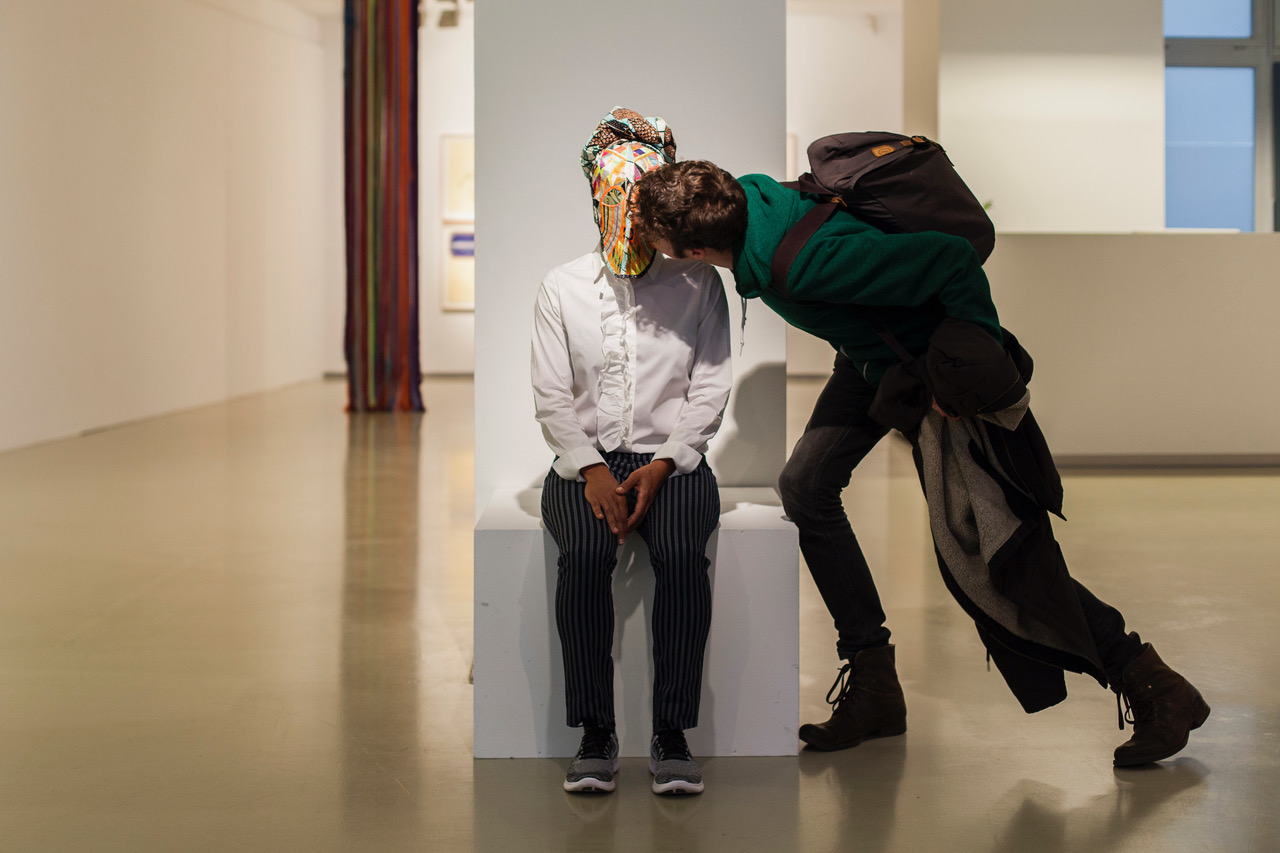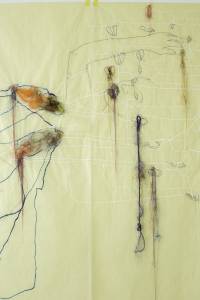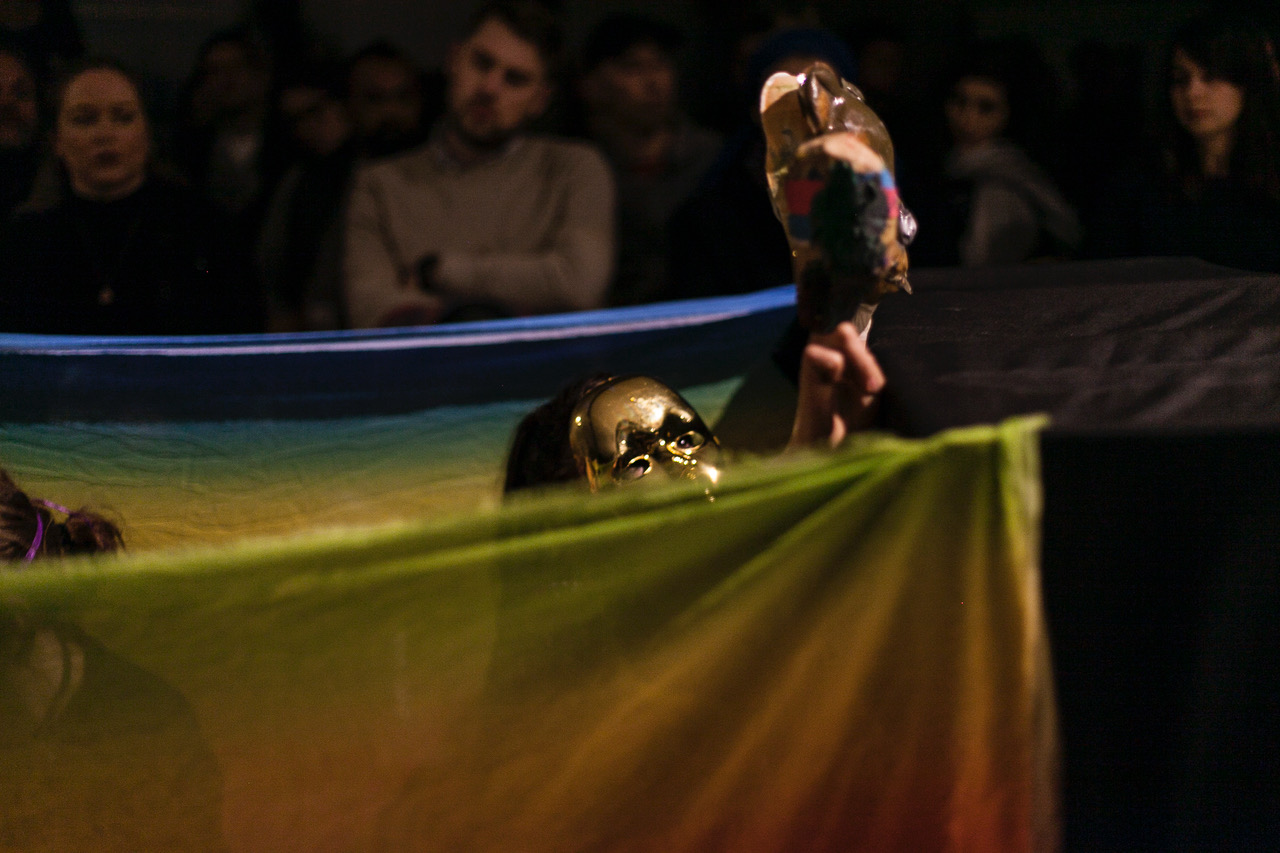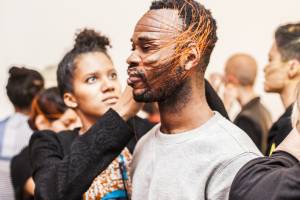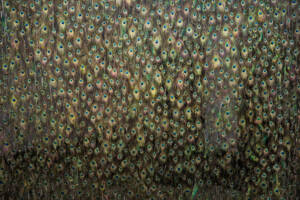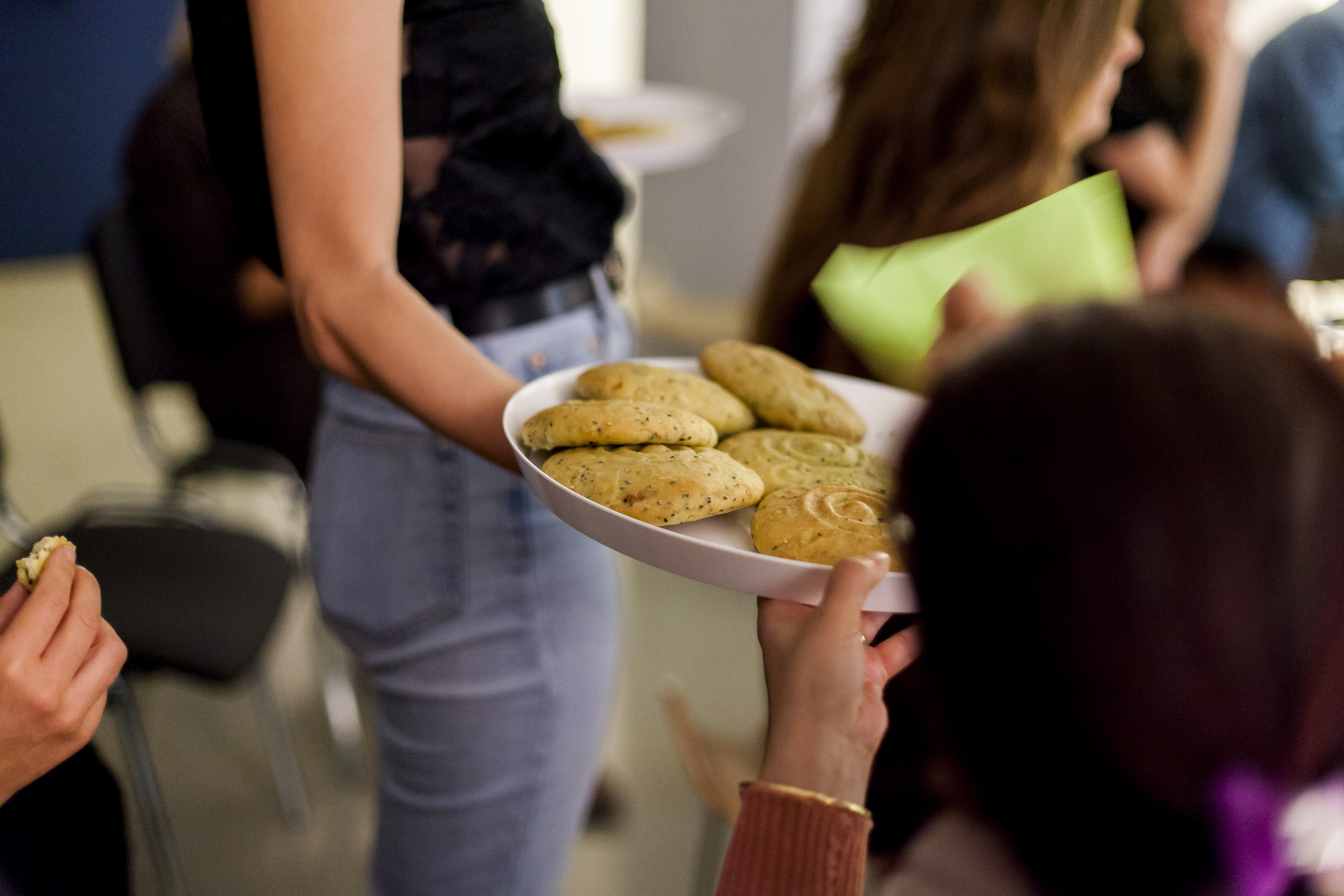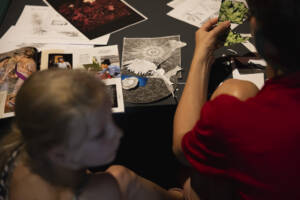The emphasis on perception, encounter and affect has underpinned a growing body of contemporary trans-Atlantic visual and performance art that critically engages with colonial histories [i] while challenging the deeply entrenched neo-colonial structures of the present. In this short reflection, I want to ask how these artworks’ use of a decolonial aesthetics of encounter (Palermo 2010, Mignolo and Lockward 2011) opens up a space for a rethinking of the social, while encouraging what Walter Mignolo has termed an “epistemic delinking” from the colonial matrix of power (2011, 54). As part of my larger current project on the aesthetics of decoloniality [ii], these are the key questions with which I engage: • How (much) does race, ethnicity and cultural background factor into the equation/experience, particularly with regard to artworks that embrace an aesthetics of decolonization? • How does the transmission of bodily affect take place from performance/ performer to viewer and vice versa? • How do explorations of moments of discomfort, un-ease, irritation or disconnect during the performance mark the limits of empathy and identification? • How do these limits demand perhaps a counter-intuitive response, a queering, a reading against the grain, an “unlearning” (Spivak 1993, 24) of intuitive interpretations, habitual correlations and assumptions that are revealed to be shaped by neo-colonial and heteropatriarchal metanarratives? • How does this encounter/experience open a space for a less “paranoid” and more “reparative” reading (Eve Kosofsky Sedgwick’s “Touching Feeling: Affect, Pedagogy, Performativity”) that urges a negotiation, interaction and a rethinking of the social? I want to address some of these questions by turning to the work of Wura-Natasha Ogunji, that I first encountered at the opening of the “Disguise: Masks and Global African Art” [iii] exhibition at the Fowler Museum at UCLA in the Fall of 2015. The temporary exhibition featured new works by twelve contemporary artists from Africa or of African descent whose work is “informed by a multiplicity of influences, from historical African masquerade traditions to contemporary global culture and digital media”. While the concept behind the curating of the exhibition was interesting – the curators centrally addressed the act of masking, camouflage, disguise as a transformative process that involves both artist/performer/artwork and viewer/audience – it was the spatial setting of the exhibition in an ethnographic museum that housed “real-life” cultural and religious artifacts from Africa, Asia, the Pacific and the Americas, that most vividly illustrated, for me, what decolonial aesthetics is, and does, in practice. A central issue that the exhibition raised, for example, was that of Anglo- European complicity in deracinating cultural artifacts from their places of origin and bringing them to another continent for display and visual consumption by a largely white audience. The dominant white gaze on, for instance, African art and its various manifestations of awe, curiosity and fascination in response to cultural “difference” and “otherness” [iv] were playfully interrupted and even reversed to a certain extent by the artwork/performance artist, who looked back at the viewer (or not). By inserting themselves into the permanent collections at the Fowler, and thus intervening in that space, the paintings, masks, performances and installations that were part of the Disguise exhibition interrogated the work of curating “ethnic” cultural artifacts. They also playfully and ironically pushed at the boundaries of museum and art gallery etiquette, that includes not getting too close to/keeping a distance away from, the artwork. Thus, the artists in the Disguise exhibition self-reflexively questioned the conventions of the museum in their artwork/ performance pieces, broaching questions about authenticity and identity within the framework of a decolonial artistic practice. The performance piece I experienced by Wura-Natasha Ogunji at the opening of the Disguise exhibition at the Fowler was The Kissing Mask, a piece based on fellow artist and collaborator Ruby Onyinyechi Amanze’s drawing, “that low hanging kind of sun, the one that lingers two feet above your head, (never dying) house plants in exchange for your freedom … orchids in exchange for your love, who are you kissing, when you kiss a mask?” (2015). In the performance of The Kissing Mask, Ogunji sits on a plinth wearing a Yoruba Egungun [v]-like mask that she describes as “a riff off of Amanze’s drawing”. A small instructional note on a stand in the corner of the performance space instructs the audience that they can kiss the mask if they would like to. Ogunji has commented on her performance piece as follows: The Kissing Mask reconnects the “artifact” to the present moment by proposing an intimate act between artist, mask and viewer. As such, this performance complicates and dismantles the mask as sacred object or historical relic by making use of it on a living, female body (that of the artist/performer). The performance also becomes a vehicle to speak about what constitutes intimacy, touch, and connection. What do we share with and show to our family, friends and strangers? Does a mask offer a space to negotiate that intimacy outside of society’s rules? Does the mask come alive only through the audience? Or simply the artist? Or, is it always charged? Do the intentions of the wearer and/or viewer affect the power and pull of the object? (artist’s blog on her website) With these questions in mind (I had read them in advance of the performance) when I crossed the threshold from audience/viewer to participant in the sight of other viewers, my act of kissing the mask was pregnant with expectation. What I had not anticipated, however, was the absolute stillness, silence and lack of response of the mask/performer to this intimate act that I had initiated because I had gone up to kiss the mask. It was comparable to what German philosopher Martin Heidegger called the “nothingness” of an “indifferent” world in his inaugural 1929 lecture “What is Metaphysics?”! Upon reflection, the act of stepping up to kiss the mask, the replica of the cultural artifact that stands for the sacred – yet is clearly only a duplication of the ‘real’ cultural artifact (that are worn by Egungun masqueraders at ceremonies) – plays with the notion of transgression, of crossing a line that destabilizes and complicates the rules of decorum and respect for the museum artifact, but also the cultural practice out of which it stemmed (for instance, people are not allowed to touch male Egungun performers or get too close; they are beaten away with sticks carried by men who accompany the performers). [vi] By wearing the mask, the female artist was also embodying the trickster figure who playfully reverses the gaze and inherent cultural expectations of the museum visitor. The mask does not belong to the viewer, nor to the museum’s permanent collection; it resists appropriation (in the form of museum labels and other signage that accompany the artwork/object on exhibition and display). Nothing happens when the mask is kissed because it is not ‘our’ property; it cannot be appropriated and it demands engagement on its own terms, and not on ours. Ogunji’s The Kissing Mask thus makes the viewer/participant deeply aware of the affective significance of the gesture of touch (or attempted touch), a natural impulse that accompanies the experience of encountering the materiality of the cultural artifact. The mask that separates two living bodies in the act of intimate encounter becomes, in the artist’s own words, “an opening, a way to claim physical, social or liminal space”. Nevertheless, this claiming is one fraught with postcolonial histories of disembodiment, deracination and racial violence. My attempt to initiate intimacy, touch, and connection was a response to, and an effort to engage with, these histories. Yet, not being able to see the artist/performer’s eyes (due to silver paper being used in the eye sockets of the mask, which reflected my own image) and expression also contributed to some uncertainty and discomfort on my part. The motionlessness of the mask forced me to read the experience counter-intuitively, to ask why there was a “lack” of response and what that might mean. [vii] Did the performer/mask not react because, although I am person of color, I am not part of the black histories and/or African culture that the performance piece referenced? [viii] What significance does race, gender and sexuality play in this interactive piece, and was the “pure”, unmediated experience [ix]that I was seeking possible at all? Was I unconsciously assuming an unmarked spectator position or, worse, guilty of a “postcolonial relativism” by collapsing my racial and cultural background with that of the performer/performance? Although these questions plagued me in the immediate aftermath of my encounter with the artwork, in retrospect, the affective intensity of The Kissing Mask lay precisely in that fleeting moment of non-reciprocated, yet deeply personal and intimate, encounter, which was the clou of the performance. The transmission of affect from the performer/mask to the viewer/audience participant through the act of kissing occurs because the gesture is not reciprocated, because of the stillness of the mask, its refusal to respond. Ogunji’s performance piece thus raised questions about how to re-negotiate and re-think forms of intimacy and encounter with sameness and “otherness”/“difference” (and the colonial ideologies and legacies that have shaped these discourses) within the framework of the ethnographic museum as an affective space. In conclusion, as a site-specific intervention within the spaces of the ethnographic museum and art gallery, Wura-Natasha Ogunji’s The Kissing Mask and her other works on display make the viewer very much aware of how, as Ngugi wa Thiong’o has put it in “Globalectics Theory and the Politics of Knowing”, the organization of space becomes a means to regulate forms of knowledge and ways of knowing (2012, 33). As artistic counter-narratives that seek to challenge and re-inscribe neo-colonial histories and ways of shaping the social, these installations and performances are thus part of a larger contemporary archive of art and literature that partakes in the crucial and enduringly relevant project of “decolonizing the mind” (Thiong’o, 1986).
[i] See also the works of, among others, Anguezomo Nathalie Mba Bikoro, Brendan Fernandes, Richard Fung, Pedro Lasch, Teresa María Díaz Nerio, Patricia Kaersenhout and Charl Landvreugd. [ii] “The Aesthetics of Decoloniality: Performance, Affect and Visual Perception” is my ongoing research project that brings together the fields of literary/cultural studies and visual studies/performance art. In this endeavor, I am certainly not alone, and I emphatically welcome collaborative exchange and conversation with other scholars and artists working on this topic. Do feel free to reach out if you feel addressed. [iii] “Disguise: Masks and Global African Art” was curated by Pamela McClusky, Curator of African and Oceanic Art for the Seattle Art Museum, and Erika Dalya Massaquoi, Consultant Curator. [iv] This, of course, refers to white European Modernism’s fascination with “Primitive” art, as the works of Paul Gauguin, Henri Rousseau and Pablo Picasso illustrate. [v] The Egungun is a Yoruba masqueraded (male) performer who is regarded as a manifestation of a dead ancestor. Women are still excluded from taking part in Egungun procession/dance rituals. [vi] Kissing a playfully created Egungun-like mask thus also encourages the viewer to transgress the taboo of not touching or interacting with ancestors from the spirit world that the Egungun masquerader represents, hence suggesting another, perhaps less heteropatriarchal, way in which to rethink established traditions and forms of the social. [vii] This absolute stillness and lack of physical movement contrasted with another of Ogunji’s site-specific performance pieces, “And Fight “(2015), in which she and Black British writer Mary Okon Ononokpono, wearing the same masks, staged acts of fighting and loving against the particular urban backdrop and architecture of Golborne Road (the “Little Morocco” of London’s Notting Hill district and home to a large ethnic minority and migrant community). See https://writinginrelation.wordpress.com/2015/07/25/and-fight-wura-natasha-ogunji-mary-okon-ononokpono/. [viii] Ogunji’s “The Kissing Mask” also references another artwork, South African artist Tracey Rose’s “The Kiss” (2001), which addresses issues of race and ethnicity, gender and sexuality. [ix] Cf. American pragmatist William James’ 1904 essay “A World of Pure Experience”. References James, William. “A World of Pure Experience”. In Essays in Radical Empiricism. London: Longmans, Green and Co., 1904. 19 – 36. Mignolo, Walter and Alanna Lockward, et. al. “Decolonial Aesthetics I”. 2011. https://transnationaldecolonialinstitute.wordpress.com/decolonial-aesthetics/. Mignolo, Walter. The Darker Side of Western Modernity: Global Futures, Decolonial Options. Durham: Duke University Press, 2011. Palermo, Zulma, ed. Arte y estética en la encrucijada descolonial. Buenos Aires, Ediciones del Signo, 2010. Spivak, Gayatri. “An Interview”. With Sara Danius and Stefan Jonsson. boundary 2 20.2 (Summer 1993): 24 – 50. Thiong’o, Ngugi wa. Globalectics Theory and the Politics of Knowing. New York: Columbia University Press, 2012. —. Decolonising the Mind: the Politics of Language. Nairobi: East African Educational Publishers,1986.
